
Owen Hargrave Suffolk (born 4 April 1829) was an English-born Australian bushranger, poet, confidence-man and author of Days of Crime and Years of Suffering (1867).

Owen Hargrave Suffolk (born 4 April 1829) was an English-born Australian bushranger, poet, confidence-man and author of Days of Crime and Years of Suffering (1867).
Owen Henry Suffolk was born on 4 April 1829 in comfortable circumstances in Finchley, Middlesex, England. He was sent to sea as a youth when his father, a London merchant, was ruined. [1]
On his return to England, Suffolk found himself homeless and fell into a life of crime. Charged with stealing in 1844, he was sentenced to a year’s detention. He was then convicted of forgery in 1846 serving time in Newgate, Millbank and Coldbath Fields prisons before being transported to Australia on the convict ship Joseph Somes in 1847. In Victoria, Australia, by his own account, he led a colorful life as a bushman, bushranger, and thief, and was frequently imprisoned as a repeat offender. During his third period of incarceration, commencing in 1858, he began writing his autobiography.
In July 1866, Suffolk received a ticket of leave, his third in Victoria, and a full pardon on board the Norfolk, which sailed for London on 20 September 1866. This pardon (in the possession of the National Museum of Australia) [2] was conditional, with the condition being that Suffolk not return to Australia. Suffolk thus obtained the neat distinction of having twice been made an exile. His story, published in The Australasian newspaper in 1867, was well-written, racy and a powerful account of criminal and prison life by an insider, one that squared well with the popular fiction of the day. [3] His account of family misfortune, ill treatment at school and at sea, subsequent misadventures, romantic interludes and descent into vagrancy and crime in London reads like a misplaced Charles Dickens plot. In Australia he tells of his youthful infatuation with crime and bushranging and his difficulties in finding honest work, and the hardships, injustices and folklore of prison life.
Back in England he quickly resumed his old habits as a confidence man, swindler and thief and added bigamist and deceiver of women. In March 1867, he married a widow, Mary Elizabeth Phelps, in London. In August 1868, Owen Suffolk, "a journalist", appeared before Lord Chief Justice Sir Alexander Cockburn at Ipswich, where he had been charged with stealing a black mare and carriage belonging to the landlady of the Great White Horse Hotel and obtaining ten pounds by false pretences. Suffolk begged for mercy on account of his de facto wife, aged 19, who was his brother's child, and her infant. The judge rejected the marriage as bigamous and sentenced Suffolk to 15 years penal servitude. By 1880 he had been released from prison and on 4 August he married Eliza Shreves at St Luke's Church in the parish of St Marylebone in London.
Suffolk began to scheme to fake his own death. He set it up by spending his spare time (which there was a lot of, as he was unemployed) rowing on the Thames. One day, when he was out boating with two others, the boat capsized. His companions were found exhausted and bedraggled on the river bank but Suffolk was thought to have drowned. Various newspaper offices were supplied with the information, headed, "Melancholy accident to an Australian gentleman." Later, it was discovered that the information had been written by the victim himself, who, by the time of the discovery, was on his way across the Atlantic with his wife's money.
He was last heard of in New York.
Suffolk is remembered as Victoria's 'prison poet' [1] and for his readable autobiography Days of Crime and Years of Suffering, [4] [5] which reveals much about London street life and the behaviour and treatment of criminals in the Victorian era. An important contribution to Australian literature, it influenced Marcus Clarke and his 1870–1872 novel For the Term of His Natural Life .

Bushrangers were armed robbers and outlaws who resided in the Australian bush between the 1780s and the early 1900s. The original use of the term dates back to the early years of the British colonisation of Australia, and applied to transported convicts who had escaped into the bush to hide from the authorities. By the 1820s, the term had evolved to refer to those who took up "robbery under arms" as a way of life, using the bush as their base.

Newgate Prison was a prison at the corner of Newgate Street and Old Bailey Street just inside the City of London, England, originally at the site of Newgate, a gate in the Roman London Wall. Built in the 12th century and demolished in 1904, the prison was extended and rebuilt many times, and remained in use for over 700 years, from 1188 to 1902.

Marcus Andrew Hislop ClarkeFRSA was an English-born Australian novelist, journalist, poet, editor, librarian, and playwright. He is best known for his 1874 novel For the Term of His Natural Life, about the convict system in Australia, and widely regarded as a classic of Australian literature. It has been adapted into many plays, films and a folk opera.

Matthew Brady was an English-born convict who became a bushranger in Van Diemen's Land. He was sometimes known as "Gentleman Brady" due to his good treatment and fine manners when robbing his victims.

The Old Melbourne Gaol is a former jail and current museum on Russell Street, in Melbourne, Victoria, Australia. It consists of a bluestone building and courtyard, and is located next to the old City Police Watch House and City Courts buildings, and opposite the Russell Street Police Headquarters. It was first constructed starting in 1839, and during its operation as a prison between 1845 and 1924, it held and executed some of Australia's most notorious criminals, including bushranger Ned Kelly and serial killer Frederick Bailey Deeming. In total, 133 people were executed by hanging. Though it was used briefly during World War II, it formally ceased operating as a prison in 1924; with parts of the jail being incorporated into the RMIT University, and the rest becoming a museum.
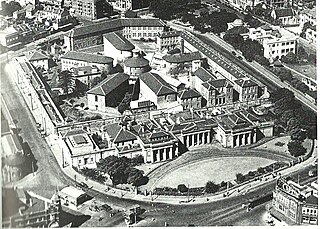
The Darlinghurst Gaol is a former Australian prison located in Darlinghurst, New South Wales. The site is bordered by Darlinghurst Road, Burton and Forbes streets, with entrances on Forbes and Burton Streets. The heritage-listed building, predominantly designed by New South Wales Colonial Architect Mortimer Lewis, was closed in 1914 and has subsequently been repurposed to house the National Art School.

Joseph Bolitho Johns, better known as Moondyne Joe, was an English convict and Western Australia's best-known bushranger. Born into poor and relatively difficult circumstances, he became something of a petty criminal robber with a strong sense of self-determination. He is remembered as a person who had escaped multiple times from prison.

Thomas Jeffrey was a convict bushranger, murderer, and cannibal in the mid-1820s in Van Diemen's Land. In contemporary newspaper reports of his crimes, he was frequently described as a 'monster'. Jeffrey and three other convicts absconded from custody in Launceston in December 1825 and were subsequently responsible for five murders characterised by extreme violence, including the killing of a five-month-old infant. Another victim was a member of the gang, killed while he slept and his flesh consumed by his companions. Jeffrey was captured in January 1826; he was tried in Hobart and convicted of various of his crimes. Jeffrey was executed by hanging at Hobart in May 1826.
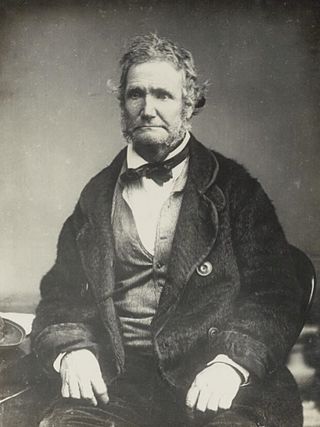
Martin Cash was a notorious Irish-Australian convict bushranger, known for escaping twice from Port Arthur, Van Diemen's Land. His 1870 autobiography, The Adventures of Martin Cash, ghostwritten by James Lester Burke, also a former convict, became a best seller in Australia.
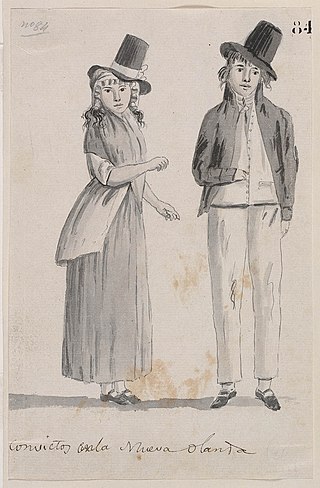
Between 1788 and 1868 the British penal system transported about 162,000 convicts from Great Britain and Ireland to various penal colonies in Australia.

William Westwood, also known as Jackey Jackey, was an English-born convict who became a bushranger in Australia.
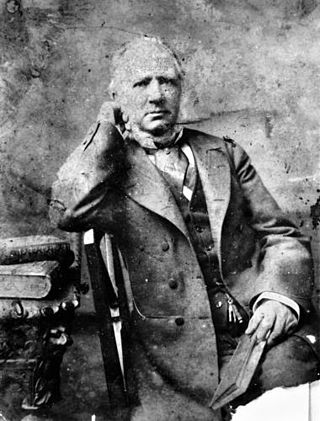
Kevin Izod O'Doherty was an Irish Australian politician who, as a Young Irelander, had been transported to Tasmania in 1849. He was first elected to the Queensland Legislative Assembly in 1867. In 1885 he returned to Europe briefly serving as an Irish Home Rule MP at Westminster before returning in 1886 as a private citizen to Brisbane.
Michael Howe was a British convict who became a notorious bushranger and gang leader in Van Diemen's Land, Australia.

Coldbath Fields Prison, also formerly known as the Middlesex House of Correction and Clerkenwell Gaol and informally known as the Steel, was a prison in the Mount Pleasant area of Clerkenwell, London. Founded in the reign of James I (1603–1625) it was completely rebuilt in 1794 and extended in 1850. It housed prisoners on short sentences of up to two years. Blocks emerged to segregate felons, misdemeanants and vagrants.
The following lists events that happened during 1864 in Australia.
David Dunstan is an Australian writer, journalist and historian.
Joseph Michael Leary, was an Australian politician and solicitor, serving as a member of the New South Wales Legislative Assembly.

James Hardy Vaux was an English-born convict transported to Australia on three separate occasions. He was the author of Memoirs of James Hardy Vaux including A Vocabulary of the Flash Language, first published in 1819, which is regarded as both the first full length autobiography and first dictionary written in Australia.

Lawrence Cummins, known informally as Larry Cummins, was a bushranger who operated primarily in the districts surrounding the Abercrombie River. In July 1863 he participated in the Mudgee mail robbery led by Fred Lowry and John Foley. Soon afterwards Cummins and his younger brother John carried out several robberies. They were identified and John Cummins was apprehended; he was accidentally shot and killed while being escorted by police constables. Three weeks later Cummins was captured with his associate Lowry, in an encounter with the police which resulted in Lowry’s death. Cummins was sent to Berrima Gaol in late 1863, from where he escaped in November 1866 with another prisoner. From December 1866 to April 1867 Cummins carried out a series of audacious robberies. In April, during an attempted robbery of Webb's store on the Fish River in company with John Foran, he received a wound in the face from birdshot. He was captured soon afterwards and sentenced to thirty years hard labour and sent back to Berrima Gaol.
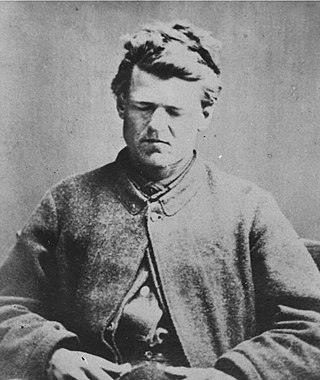
Bluecap was an Australian bushranger. Born and raised in New South Wales, he began bushranging in 1867, leading a gang responsible for robberies throughout the Riverina region. He suffered from ophthalmia, and earned his alias on account of a piece of cloth he wore to protect his eyes from sunlight. Captured in November 1867, Bluecap was tried and convicted of armed robbery. He was imprisoned in Parramatta Gaol and released in 1874.
{{citation}}: CS1 maint: multiple names: authors list (link) CS1 maint: numeric names: authors list (link)